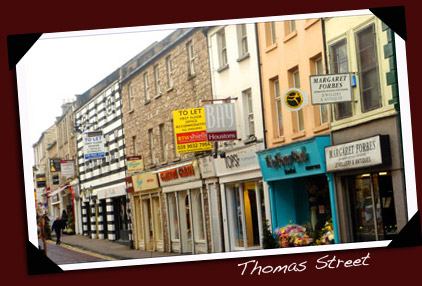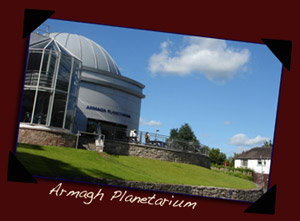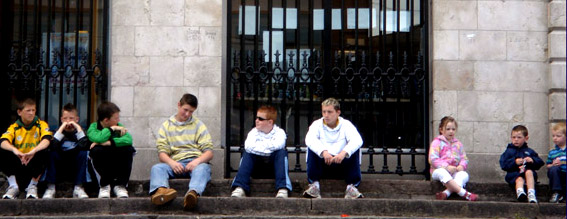Story by Juanita Dudhnath
 Armagh: a city of two cathedrals, a city on seven hills, the city of legends. Armagh: a city of two cathedrals, a city on seven hills, the city of legends.
She boasts a strikingly colorful history. The oldest city in Ireland, Armagh has played host to the first Celtic high kings of Ireland, St. Patrick, and Jonathan Swift, the author of Gulliver’s Travels. Armagh gives voice to the spirits of two Christian faiths, seen in the crowds of worshippers each Sunday at two commanding cathedrals situated on twin hilltops. Armagh sings the tune of myth and legend; outside the town, visitors can find one of the Gaelic world’s most ancient ruins, Navan Fort, known as Emain Macha (the “twins of Macha”). The city is a destination that combines traditional small town charm with extraordinary attractions.
Armagh seems bewitched with charm. Traditional in style, jewelled with cobblestone streets, Irish pubs, and tiny colorful boutiques, Armagh lives and breathes the quiet of a Sunday evening, where you bask in the smell of a fresh batch of cookies and the warmth of peat fires. It’s the place Grandma and Grandpa settle down to tell you Irish stories and legends over tea.
The City of Two Cathedrals
One of those stories surely must be the adventures of St. Patrick (Padraic), who came to Ireland in the 5th century to christianize the country. Remnants of his presence are everywhere in Armagh. Standing on this city of hills are two St. Patrick’s cathedrals, each dominating the streets and glens of the town far below.
 The protestant St. Patrick’s Cathedral (Church of Ireland) stands on Sally Hill at the very crest of Armagh’s City Center. Druim Saileach (Sally Hill) is the place St. Patrick chose as the base from which to spread his faith; he first built a stone church in 445 A.D. on the site where the cathedral stands today. The cathedral we see – a stout russet-colored Gothic restoration surrounded by rose gardens, bishop’s homes, and broad green spaces flecked with family gravestones – has been rebuilt 17 times, most recently from 1834-1840. But it contains many relics of history, among them a true stone High Cross and the grave of Brian Boroimhe (Boru). Taken together the churches on Sally Hill have survived island war, Cromwellian purges, and the modern-day “troubles.” The protestant St. Patrick’s Cathedral (Church of Ireland) stands on Sally Hill at the very crest of Armagh’s City Center. Druim Saileach (Sally Hill) is the place St. Patrick chose as the base from which to spread his faith; he first built a stone church in 445 A.D. on the site where the cathedral stands today. The cathedral we see – a stout russet-colored Gothic restoration surrounded by rose gardens, bishop’s homes, and broad green spaces flecked with family gravestones – has been rebuilt 17 times, most recently from 1834-1840. But it contains many relics of history, among them a true stone High Cross and the grave of Brian Boroimhe (Boru). Taken together the churches on Sally Hill have survived island war, Cromwellian purges, and the modern-day “troubles.”
St. Patrick and the Deer or Lorica’s Cry for Protection
Irish legend consistently connects St. Patrick and deer. One of the most famous stories concerns St. Patrick’s prayer, known as Lorica’s Cry for Protection. It is said that a high king of Ireland Laoghaire on the eve of the Easter festival was conducting celebrations in neighboring Slaine while St. Patrick built his own fire on Tara (a neighboring location) as he attempted to preach to the people. Distracted by Patrick’s speech and the fire, the high king believed Patrick was infringing on his festivities. He summoned Patrick for questioning, but as the druids waited in the hedges to kill Patrick, all they could see was a doe followed by nineteen fawn. St. Patrick had sent up a special prayer, a cry for protection known as Lorica’s cry, and he and his followers were magically transformed into deer. After the soldiers grew impatient and departed, Patrick and his 19 followers miraculously returned to human form. |
Less than a mile away, the twin-spired Roman Catholic St. Patrick’s Cathedral forms a beacon in the sky. The story goes that Patrick walked here. After demanding that the Archangel Gabriel help him convert all of Ireland to Christianity, Patrick chose a hilltop in Armagh to build the first church. In trying to take possession of the hill, though, he startled a doe and its fawn. When they ran away, Patrick followed them, and in doing so caught the fawn and gently lifted it and carried it down the hill while the doe followed behind. Patrick crossed a small glen, then placed the frightened animal on the slope of the neighboring hill called “Telach na Licci” (Sandy Hill). This legend would serve as the inspiration for building the second (Roman Catholic) cathedral on Sandy Hill. (For more on St. Patrick and the magical deer, click here.) [hyperlink below]
One hundred fifty years ago the Roman Catholic cathedral was built to honor St. Patrick’s memory. Construction of this richly appointed, Italianate church began in 1840, but work was suspended temporarily during the Irish potato famine, where church monies went to aid victims. The church has since been completed and embellished with a lovely carillon and both ancient and modern relics.
Most surprising is the coexistence of both protestant and Roman Catholic cathedrals in Armagh, part of once protestant-dominated Northern Ireland. Today, the peaceful co-existence of both religions alludes not only to Ireland’s, deep-rooted past but to the blood kinship Irish Catholics and protestants share. The cathedrals stand as monuments to the hope for future peace, the bond of Christian faithful everywhere.
The City of Sagas
Armagh is said to be named after the legendary warrior, Queen Macha. She was married to a lord named Crunniuc of Ulster. One day the couple attended a horse racing fair. Crunniuc, who knew his wife ran with lightning speed, had been warned not to boast. But he insisted that his wife could run faster than the king’s chariots, so a deal was struck. If Macha failed to outrun the royal horses, her husband Crunniuc would be put to death for his blasphemies.
Macha prevailed, but after the race she gave birth to twins, a son and a daughter. Their birthplace is alleged to be Emain Macha, “twins of Macha,” in Gaelic, a magical place located at the Navan Fort. Macha gave Ulster both the blessing and the curse of power, kingship, and continuous war. She is celebrated in the abundant archaeological relics found at Navan Fort, which has a museum and multimedia interpretive center.
Other Attractions
 For a town of merely 15,000 residents, Armagh boasts many historical sites worthy of attention. In addition to the cathedrals and Navan Fort, Armagh has an active astronomical observatory and planetarium, a modern entertainment and cultural facility known as the Marketplace Theatre & Arts Centre, seat of the annual John Hewitt International Summer School, which attracts Irish journalists, poets, playwrights, and political figures, and several major public libraries, the AmmA Centre, St. Patrick’s Trian Visitor Centre, and assorted pubs, art galleries, museums, shops, and abundant restaurants of all flavors and nationalities. The surrounding countryside is rich Irish pastureland. Armagh’s famous Apple Orchards manufacture some of the Ireland’s most tasty cider. In all, a great touring experience in a historic Northern Ireland town. For a town of merely 15,000 residents, Armagh boasts many historical sites worthy of attention. In addition to the cathedrals and Navan Fort, Armagh has an active astronomical observatory and planetarium, a modern entertainment and cultural facility known as the Marketplace Theatre & Arts Centre, seat of the annual John Hewitt International Summer School, which attracts Irish journalists, poets, playwrights, and political figures, and several major public libraries, the AmmA Centre, St. Patrick’s Trian Visitor Centre, and assorted pubs, art galleries, museums, shops, and abundant restaurants of all flavors and nationalities. The surrounding countryside is rich Irish pastureland. Armagh’s famous Apple Orchards manufacture some of the Ireland’s most tasty cider. In all, a great touring experience in a historic Northern Ireland town.

Story by Juanita Dudhnath
Photography by Chrissy Doughty
Video by Caitlin Robirds
Web design by Brigid Carey |

